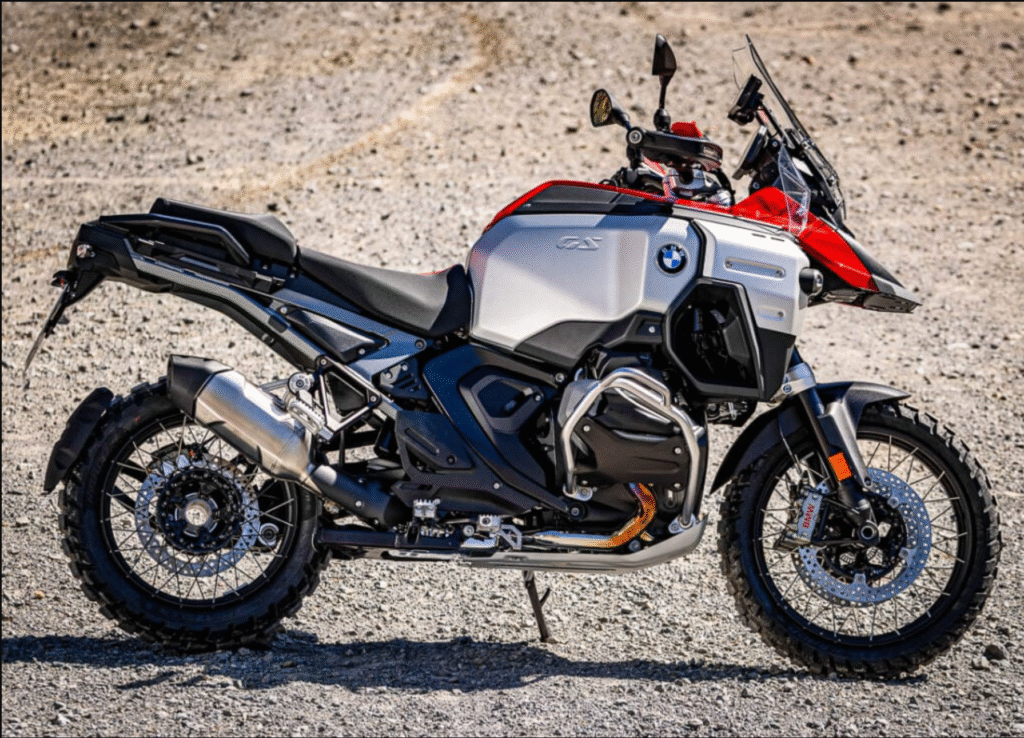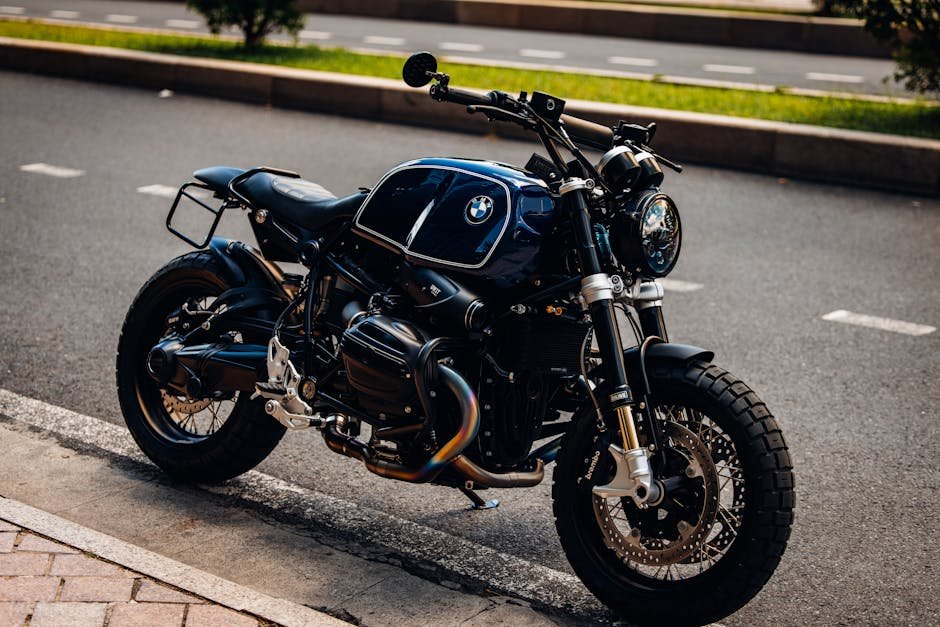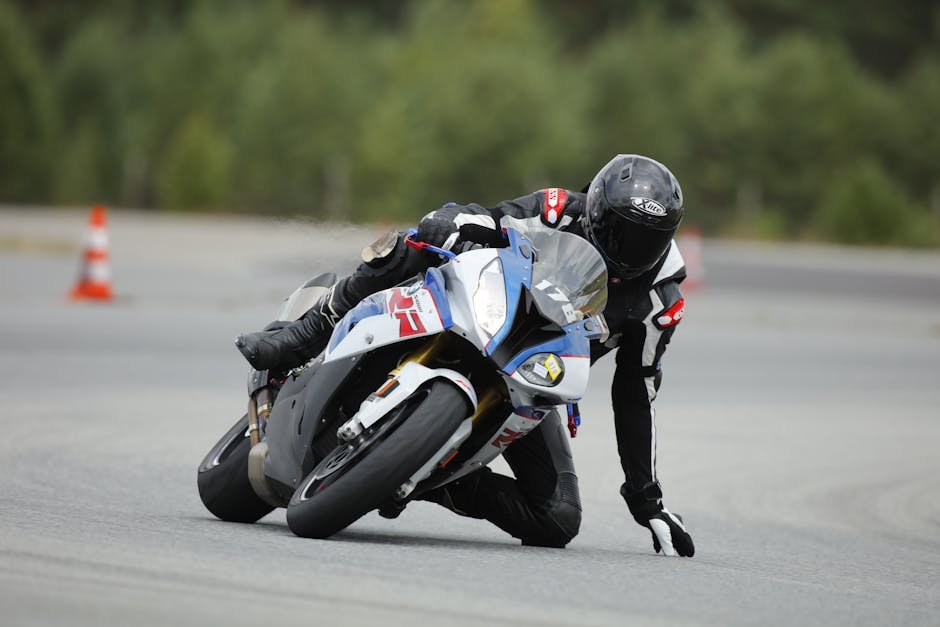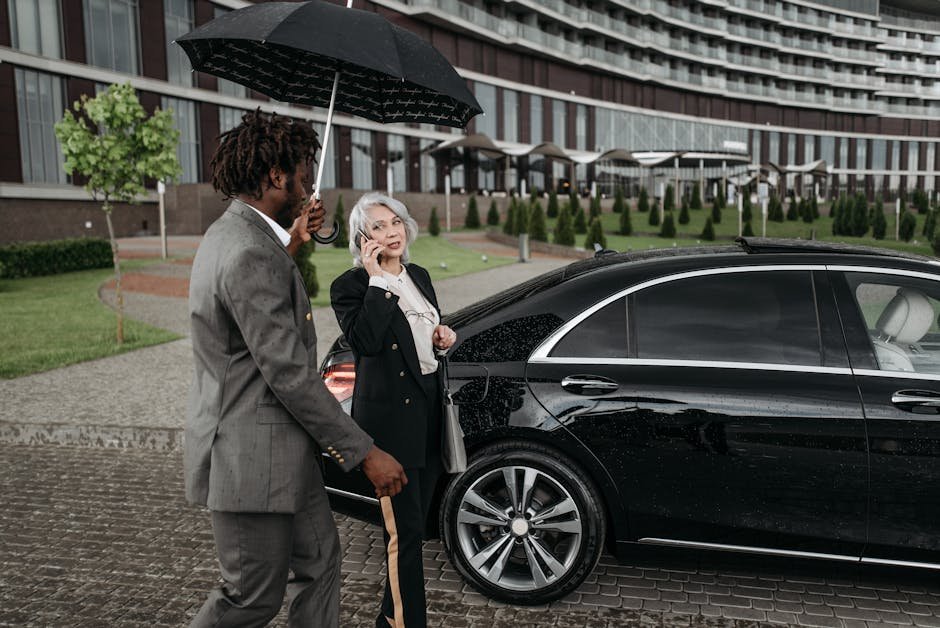Table of Contents
Evolution of an Icon
It is hard to imagine the BMW GS line without its place in the market. Ever since the off-road/road GS models were introduced, they have been the gold standard for large adventure motorcycles. BMW’s task with the 2025 R1300GS was not easy: they had to update their most important adventure bike, including more power and technology, while keeping the charm that made it a legend in the first place. In theory, they did it perfectly. The R1300GS has a larger engine, it is lighter, and it also has many new features. In terms of design, the GS is still recognizable – its sporty stance, beak, and the front fuel tank which is prototypical 5 gallons – but, a closer observation shows that it has a more contemporary bodywork and a compact LED headlight assembly. Once you get on, the first thing you feel is that it is a bit slimmer between the knees compared to the outgoing R1250GS. This little change alludes to one of the biggest revisions: weight loss.
BMW engineers were able to get about 26 pounds off the R1300GS rather than the older one. In the 1200cc ADV sector, thus, winning 26 lbs is a big deal. A lot of the weight cut is thanks to an entirely new frame shape and a swingarm that is both lighter and is shaft-driven. You notice the difference immediately when you pick the bike up off its sidestand – it’s still a beefy rig (~523 lbs wet), yet it takes less work to get it up. At low revs or when in the garage, the freshly updated GS seems considerably more manageable, which is a great positive for numerous cyclists. Most impressively, BMW has managed to cut weight without affecting the bike’s solid build or fuel capacity. Parked next to an R1250GS, the R1300GS even has the air of a neater machine – it’s as if it has been through the gym, shedding unnecessary weight. “Lighter and faster” is the slogan that BMW has attached to this model, and at least in terms of weight, they have kept their promise.
More Muscle from the Boxer Twin
The “1300” in R1300GS is not just for appearance; BMW has extended its signature boxer-twin engine to 1300cc (from 1254cc). This has been achieved through the modification bore and stroke, which has resulted in output graphically better. The new liquid-cooled boxer reaches the peak power of 143hp at around 7,750 rpm and about 110 lb-ft of torque at 6,500 rpm. For comparison, this means approximately +9 hp and +4 lb-ft more than the former R1250GS, thus making R1300GS almost the top of the segment in engine metrics. Just a few, such as Ducati’s Multistrada V4 or KTM’s 160hp 1290 twin, can top this bike, while GS boxer is hanging with them.
What is impressive is that, even with the new, more powerful motor, the GS has not lost its friendly character. Start the boxer and it automatically enters that very recognizable sideways rumble particular to BMW’s flat twin. Open the throttle and you can immediately feel the extra power – it is a little bit more vigorous, chiefly in the medium-to-high rev range. The older model 1250 had a lot of low-end torque (the new one 1300 has that too), so to start off the line the feeling is akin to: strong, tractor-like pull from down low. But as the revs jump up, the 2025 latest model has a bit lots of shine. You could notice it during the highway acceleration; it seems it doesn’t abolish the oxygen at higher revs as quickly; it pulls strongly towards the redline with a gust of satisfaction. BMW seemingly had a look at the intake system.
Agile Handling On and Off Road
Rider community respectability of the GS comes from the fact that it not only surpassed the previously considered boundaries of the general perception of how a big adventure bike can do, but it also continued doing this with the newly launched one. As a result of the weight decrease and some changes in the chassis, the 2025 R1300GS has become even more nimble. The company has kept its characteristic Telelever front suspension (which breaks the link between braking and suspension travel) and Paralever shaft-drive rear, but they have both been upgraded. The Telelever “EVO” front has new geometry and linkage to improve steering feel, and the latest Dynamic ESA electronic suspension adjusts damping on the fly to match conditions and riding modes.
The R1300GS almost behaves like a sport-touring bike on the twisty paved roads. For a motorcycle with a 19-inch front wheel and long-travel suspension, you can lean into corners surprisingly easy. It also seems to switch directions side to side much quicker now – all those ~12 kg (26 lb) less are felt instantly during the S-bend flicking. You hold the wide handlebars, tilt your body to the side, and the GS takes that personal request with joy for the precise line through sweepers. Even at extremely high speeds, the R1300GS stays on the road like it is on rails as it turns through fast curves at a speed of over 80 mph. The Telelever front keeps the chassis composed and balanced even if you decide to brake mid-corner or if you hit a bump – there is no dramatic fork dive that a regular setup would provide, hence the confidence is boosted when riding hard.
Technology and Touring Features Galore
Originating from the beginning, BMW has always been a leader in the introduction of technology in motorcycles, and the 2025 R1300GS is the best GS to date. Additionally, the motorcycle now features a bright, large TFT, which is better than most having smart phone connectivity and turn by turn navigation (via BMW pic) besides a wide range of customizable readouts. Typing readable stuff like pressures, suspension changes, and the option to integrate a GoPro or music controls are just some of the added perks. You can manage the interface with a multi-controller wheel that is located on the left grip, making it simple to operate – this is a system that BMW has improved over the years and once you get used to it, it works well. Riders switch between multiple ride; Road, Rain, Dynamic (sport), Enduro, and Enduro Pro (plus user-defined modes are available). Each mode modifies the throttle response, traction control, ABS operation, and suspension damping. In real-life terms, the new mode that switches to Enduro mode will operate the bike quite differently, it is like driving two different vehicles, one is tarmac and the other is dirt road.
On the Road: Long-Haul Comfort and Touring
After a day filled with different types of riding, I have realized that the R1300GS is not all about the specifications; it should be about giving the riders the GS experience that they love, which is now enhanced. BMW has cleverly decided to keep the rider triangle (handlebar-seat-footpeg positioning) as it is. The sitting position is erect and roomy, which gives an unobstructed perspective over the traffic and also a very comfortable stance for the long rides. The new seat felt a bit more padded than before; I traveled multiple 100+ mile trips with only a slight soreness, which means the foam was denser or shaped better.
Wind protection is slightly better too. The adjustable windshield is now a different shape, and it along with the side deflectors works to manage airflow effectively. When I rode at the speed of highways, I realized I had less turbulence in my helmet compared to the previous model-It was possible for me to ride with my visor cracked open without experiencing excessive buffeting. It’s not quite as cocoon-like as a Gold Wing (you still get a bit of wind on your shoulders), but for an adventure bike it’s truly excellent. Riders who plan to ride seriously could go for a much taller aftermarket screen, but the stock one is a formidable all-rounder, offering off-road visibility and on-road comfort benefits in equal measure.
An intriguing observation: BMW claims to have improved fuel efficiency despite an increase in power. I reset one of the trip computers for a stretch with a variety of riding involved (including highway cruise, mountain curves, and some off-road) and saw about 42 mpg on average. While cruising on a low gear, it was even closer to 45 mpg. The 5-gallon gas tank is on the lower end of the price comparison, with a range of 200 miles estimated, which is good for adventure touring. The hard-core distance riders might still dream of that larger one with a possible “GS Adventure” model (speculation is that R1300GSA is on the way), but for most of the trips, the range of a standard model is enough.
The new GS also enjoys a telelever front end which is now refined and offers more feel than before. Previous GS generations had one drawback that the riders sometimes felt which was the front end feel which was a little vague on the max lean. BMW worked on the Telelever geometry and the damping characteristics to do this. I discovered I could trail-brake into corners easily while being able to tell what the front tire was doing. The feedback is still a cute different compare to the fork (Telelever’s anti-dive function isolates you thus not getting the shocks of the sharp bumps very much), but it’s better that it is now so that toasting the GS on the curves is really enjoyable and it’s reassuring. The bike loves being ridden this way – it is often referred to as the “sport bike of ADV bikes,” and it was true during my test.
Crossing unpaved roads and offroad, the GS’s suspension, in another way, becomes the star: comfort. In Enduro mode, Dynamic ESA decreases the damping hardness, and the washing board gravel and the potholes riding were plushly impressive. I was able to stand on it throughout the mild bumps without getting jarred, yet the bike never seemed uncontrollable or bouncy. This ability to swallow bumps while remaining composed is what makes the GS such a brilliant all-rounder. One moment you are scraping pegs on asphalt switchbacks, the other moment you are gliding over rutted dirt track- both scenarios are easily done with it.
Over 300 miles of varied rides (highways, city, twisty passes, and dirt tracks), the R1300GS came out with minimum complaints. The name, “Adventure King,” has been used for the GS, and it still seems appropriate. Of course, there could be a smaller bike like the Yamaha Ténéré 700 that is lighter off-road, and there is a bigger engine competing rival like Ktm’s 1290 that can approach a higher peak power this notwithstanding the GS on a balanced configuration and expert finish still carries the day among many riders. What binds together all the elements is the telelever grip, the engine that is also very powerful but still easy to control, the electronics that not only work but also make the whole process more straightforward, and finally the weight which is less making everything a bit easier.
Conclusion: Reigning Supreme
The 2025 BMW R1300GS was impressive in the shadows of its predecessor, and it clearly has the boldness to do so. With the new engine, aluminum frame, and gadgetry, the GS design does not just remain the same, but it becomes the best in the class. My riding test, which was done in various conditions, is enough to say that the R1300GS is still one of the most adaptable motorbikes on this planet. It genuinely gives the impression of being a tiny bit lighter and provides even more immediate reactions, but on the whole, it still feels rock-solid and very reassuring – that’s a thin line you have to walk. Most importantly, it keeps that magical GS aura: when you are in its saddle, nothing seems impossible, be it a long or difficult journey.
Indeed, such excellent performance is associated with a high price. The R1300GS is not an entry-level motorcycle, particularly if you add options such as an adaptive suspension, radar cruise, luggage, and more on it. However, you essentially have three bikes in one: a long-distance tourer, a sporty canyon carver, and a capable off-road explorer. Hardly, if at all, any other manufacturer manages to combine those two identities in such an unobtrusive way. BMW’s large number of dealerships across the globe and the aftermarket network are a reassuring factor for long-distance travelers and the GS will, therefore, remain among the top choices for many adventure riders.
“Lighter, Faster, and Still the Adventure King” – after this experience, I would not shy away from stating that this slogan is not just marketing drivel. BMW has managed to evolve the GS concept without the need for a revolution, and that is likely how it should be for the loyal customers. The 2025 R1300GS is completely the same as the king it has been for every other model in the past, it just has a more aggressive and streamlined design. If you are looking for motorbiking that can do anything in 2025, the R1300GS should be the very first in your sight. Long live the king – it looks like it is firmly rooted on the throne.
FAQs :
What are the main upgrades in the 2025 BMW R1300GS compared to the previous R1250GS?
The R1300GS features a larger 1300cc boxer-twin engine producing 143 hp and 110 lb-ft of torque, a 26-pound weight reduction, and a redesigned frame and swingarm for improved handling. It also introduces advanced features like Adaptive Ride Height, radar-based Adaptive Cruise Control, and a refreshed LED headlight design with sleeker bodywork.
How does the Adaptive Ride Height system improve accessibility?
The optional Adaptive Ride Height automatically lowers the bike’s suspension by about 1.5–2 inches when coming to a stop, making it easier for riders to plant their feet on the ground. Once you start riding, the suspension returns to its normal height for full ground clearance. This feature is especially helpful for shorter riders or those handling heavy loads.
Is the 2025 R1300GS suitable for both on-road and off-road riding?
Absolutely. The R1300GS is designed as a true adventure bike with advanced suspension (Telelever EVO and Paralever), Dynamic ESA for real-time damping adjustments, and multiple ride modes including Enduro Pro for off-road conditions. It’s agile on twisty roads, stable at high speeds, and capable on gravel or dirt trails — making it one of the most versatile bikes in its class.




